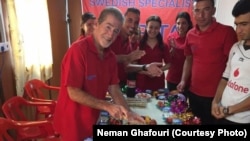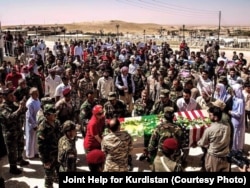It has long been a tradition of the ethnically Kurdish Yazidi community to bury their loved ones in their holiest shrine of Sharfadin in the Iraqi Kurdish region in Dohuk. Allowing people from other religions to their holiest site was unheard of until this Thursday, when hundreds of Yazidis headed to the shrine to bury an American volunteer.
Leland Stanford Scott, 67, was a retired sergeant from Seal Beach, California. Better known to the Yazidi community as Mr. Lee, Scott taught the English language to Yazidi students in their refugee camps in Iraq.
He died of a stroke earlier this month in the Kurdish region that also became his last resting place.
Travel to Iraqi Kurdistan
Scott traveled from Seal Beach, California, to the Kurdistan region four months ago after he heard about the Yazidi exodus from their lands following Islamic State attacks.
Upon his arrival, he contacted Joint Help for Kurdistan, a Swedish-Kurdish organization assisting NGOs and individuals to provide funds and volunteer support to displaced Yazidis.
“Mr. Lee contacted me in February and said he wanted to serve the people in need,” said Nemam Ghafouri, the chairwoman of the organization. "He told me that he only booked a one-way flight ticket, and he was willing to stay as long as people needed him,” she told VOA.
Ghafouri and Scott agreed that he would teach English to young Yazidi children at Bajid Kandala 2 refugee camp, where her organization was providing help to the refugees.
Scott started teaching English three days a week to 150 Yazidi children who soon became a new family to him, according to Ghafouri.
Life in the refugee camp
His relationship to the people of the camp quickly changed in a way that took everyone by surprise.
“Mr. Lee soon became like a father to the young and the old in the camp,” Ghafouri told VOA.
In addition to teaching English, he organized sports activities such as evening jogs for the displaced people in the camp.
“We told him engaging teenagers of the camp in some physical activity would be great,” Ghafouri said. “But later, even the grownups joined his evening runs.”
It was his love of his newly adopted land and the Yazidi community that ultimately convinced his family to make Iraqi Kurdistan region his final resting place.
Burial ceremony
“Lee had found forgiveness and redemption through the love the Yazidi people had for him,” his daughter, Talea Scott Hoffman, wrote in a message to the displaced Yazidis of the camp.
“Mr. Lee loved the Yazidi people so much and he wished to remain with them for as long as he was able,” Hoffman wrote. “He spoke often of his Yazidi family and shared many photos and stories with those of us in the U.S.”
His family wished to bury him in the holly Yazidi shrine of Sharfadin, where hundreds of Yazidis killed by IS are buried.
“We, his family, believe he would have wanted to have his earthly body buried among the Yazidi people who he loved and, therefore, have decided to have him interned in Sharfadin in Kurdistan,” Hoffman wrote.
But burying a person of another religion in the holiest shrine of Yazidis has not been a tradition among the Yazidis.
When Ghafouri convoyed the wish of Scott’s family to the Yazidi community in the camp, it did not take them long to make a decision.
“Everyone started crying when I told them,” Ghafouri said. “They said it was an honor for them to host such a hero forever in their land.”
Scott’s burial ceremony was attended by hundreds of people carrying signs expressing gratitude to his work for the displaced Yazidis.
“He was spending his money to help people,” Emina Musa, one of his students, told VOA. “His soul will last for eternity.”
VOA's Salam Balay also contributed to the story from Dohuk, Iraq.








